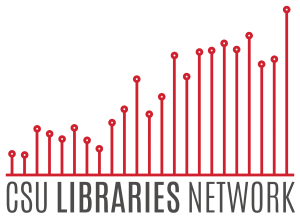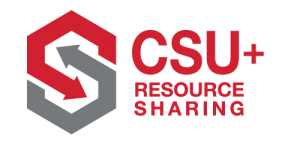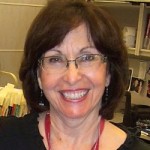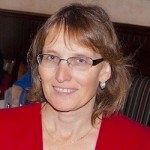Makerspaces have become increasingly popular additions to libraries, allowing visitors to learn and apply hands-on creative skills in tandem with traditional scholarship. Several CSU campus libraries have developed maker spaces, adopting maker culture, which values creation as an alternative to consumption. Both makerspaces and libraries provide informal learning opportunities, so it’s not surprising that libraries are serving as facilitators and incubators for the accessible, collaborative culture that makerspaces strive to create, according to Isis Leininger, Coordinator at Oviatt Library’s Creative Media Studio, CSUN.
“Beyond just providing access to innovative technologies, makerspaces are a place to discover those technologies, use them, and in turn cultivate student engagement,” added Jenny Wong-Welch, Director at Love Library’s build IT, SDSU.
Establishing a makerspace
Both the Creative Media Studio at Oviatt Library and build IT at Love Library were among the first mini makerspaces to appear on CSU campuses. “In the beginning we had a more basic makerspace focusing on providing more general, multimedia software and better cameras in response to increased multimedia projects in classes,” Leininger said. “But now we’re going beyond equipment.”
According to Wong-Welch, the makerspace that she helped to found grew out of a personal interest in technology. “Right about the time I started doing 3D printing, I did some workshops, so that became the stepping stone for incorporating my own interest in electronics into helping students actually make things,” Wong-Welch said.
-
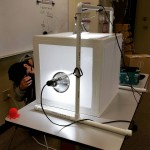
-
A light box, built in build IT, can now be used by other makers to show off masterpieces.
-
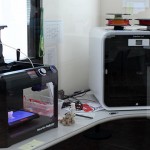
-
Build IT’s 3D printers are busily bringing forming imagination into reality.
Benefits of a makerspace
From virtual reality equipment to advanced digital editing software, students have access to explore and utilize a variety of tools and platforms. Even in their infancy, the two makerspaces at Love and Oviatt libraries have given students opportunities to grow beyond what they learn in the classroom.
“Students here are really gaining the opportunity to build interdisciplinary skills and go beyond their major. Meeting people from other majors and being in a collaborative environment like this is preparation for their future careers,” Leininger said.
“I think that this learning community helps to build universal digital skills in a newer manner than you would in a class. But you are also building workplace skills and you get a chance to learn about the design process which lets you conceptualize, design, engineer, evaluate, and reiterate,” Wong-Welch added.
Campus receptiveness
Building a community is at the core of the makerspace ethos, and Leininger believes the makerspace she coordinates has been successful at not only attracting students but cultivating a community.
“Students here are engaged and love being here. The recording studio is pretty much occupied all the time. People from all different majors have come together to make this a very popular space,” Leininger said.
Student involvement
Students excited to learn and share new skills become so highly involved with these spaces that makerspaces are able to organically foster student communities and connections, Leininger explained. Oftentimes, students have the opportunity to play larger roles within their makerspace community as student assistants.
“The biggest way to keep a makerspace going is to involve students and give them ownership of their learning community, so that they can call it their own and feel more invested,” Wong-Welch added. “By maximizing student engagement we are also providing internships and work experience that could lead to real jobs.”
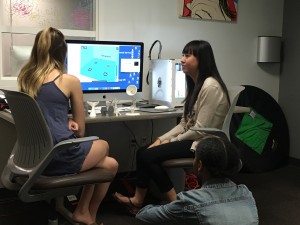
CMS student assistants, Alyse Kollerbohm, Rose Rieux, and Eva Cohen, training each other on 3D modeling and printing.
Future plans and opportunities
As library makerspace communities grow, staff are actively planning to provide students with greater access to more maker tools and nurture even more creativity across their campuses.
“I think makerspaces will become even more popular and become part of every library. We’re looking forward to expanding and we’re always trying to improve,” said Leininger. “Hopefully if we get enough funding we can start a maker club and get a green screening room next.”
“What I love about the makerspace is that students might have an idea and they know that there is a community where they can actually produce what they envisioned,” Wong-Welch said. “And I believe the library, as a huge social hub of different students, is a great place to foster and help actualize those ideas.”
Maker culture across the CSU
Many other CSU libraries are enhancing their campuses’ learning potential by fostering maker culture. Here are some of the exciting initiatives being implemented.
- Cal State San Bernardino, launched fall, 2015
- San Jose State University, launched fall 2015 – fall 2016
- Creative Media Lab: Students use this lab for high-end video and audio editing, animation and game development
- 3D Printing: Piloting 3D printing in the library with a TAZ Lulzbot 5, and adding a Lulz Mini and Glow Forge 3D laser printer
- Maker Technology Checkout: Raspberry Pis, Arduinos, makey makeys, 3D printing pens and Google Cardboards are available for checkout
- Pop-Up MakerSpace: Converting laptop storage cart into a convertible maker space. It will include the kits listed above, soldering kits, servo kits and a mini 3d printer.
- San Francisco State University, launched November 2015
- Cal Maritime, launched September 2014
- Maker Days: Monthly events, ranging from Arduino and 3D printing to quilling and pumpkin carving.
- Sonoma State, launched January 2016
- Innovation Lab: Partnering with SCI220, a science class, the Library piloted an Innovation Lab in January 2016 in a Library classroom. The lab featured 3-D printers, Arduino kits, and other gear. The pilot was deemed successful, and SCI220 will be repeated in the fall of 2016. Additions to the lab for fall 2016 may include a 3D Scanner and Raspberry Pi computing.
At time of publication, still more programs are taking shape across the state. At Cal Poly San Luis Obispo, Robert E. Kennedy Library is collaborating with the campus’ Innovation Sandbox to expand and move their location to the library. Cal Poly Pomona University Library has allocated a section of their building for a maker space with plans to hire staff. At Chico State, the Meriam Library plans to establish a maker space in the future, and the Sacramento State University Library is in the process of raising funds.
CSU libraries are operationalizing maker culture in a variety of styles, formats, and programs, but their goals remain consistent: provide access to information and technology, teach new skills, and create a safe, welcoming learning environment. These core values have always been at the heart of the libraries’ mission, and the future holds exciting possibilities for maker culture to continue enriching library learning.
Read More

